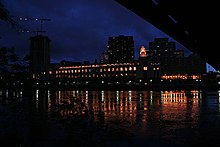Magney And Tusler
History
Ard Godfrey operated the area's first post office in the village of Saint Anthony on the Mississippi's east bank during the early 1850s. At first unpredictably, deliveries came by messenger from Fort Snelling through Saint Paul, Minnesota. Later, mail arrived by stagecoach every ten to fourteen days. The first post office in Minneapolis was built on the west bank on High Street in 1854 and operated by postmaster Hezekiah Fletcher.
The present day post office was completed in 1933 and occupies nearly the same site. The main building faced Pioneer Square park, which is now occupied by an apartment tower. A companion federal office building at a right angle to the post office on the park's western perimeter was suggested in 1934 but not built.
A seven-level parking ramp and loading dock for bulk mail were added to the west in 1976.
In 2023, it was renamed in honor of former Minnesota Congressman Martin Olav Sabo.
Structure and interior

The post office was built of granite and stone in the PWA Moderne Art Deco style at the cost of $4.5 million or about $64 million in 2006 USD. Léon Eugène Arnal, the chief designer for the architects Magney & Tusler, designed the building. Between 1885 and 1946, Magney & Tusler designed the post office, and designed or co-designed the Foshay Tower downtown, the Calhoun Beach Club on Bde Maka Ska, the Lehmann Center on Lake Street, the Young-Quinlan Department Store on the Nicollet Mall and the former home of Teener's Theatrical costume and props store on Hennepin Avenue among other buildings in Minneapolis. The firm was later known as Setter, Leach & Lindstrom, acquired by Leo A. Daly in 2003.
The main building is 540 feet (165 m) long. Its interior is unchanged and postal customers still utilize its original bronze teller cages and fixtures, marble terrazzo floor and sandstone walls. Perhaps the longest light fixture in the world, a 350-foot (107 m), 16-ton (16256.8 kg) bronze chandelier runs the length of the lobby, originally designed to regulate temperature.
Peepholes were installed in the corridors so that inspectors could protect the mail and observe employees. The main building contained a three-room suite paneled in walnut for the postmaster, recreation rooms and a hospital unit for employees as well as a rifle range in the basement.

References
- ^ MacIntosh, Craig (art) and Eglitis, Ilga (text) (1986). Minneapolis Cityscape: An artist's view. Flanagan, Barbara (foreword). MACILO Publishing Co. p. 42. ISBN 0-9616512-0-2.
{{cite book}}: CS1 maint: multiple names: authors list (link) - ^ Board of Park Commissioners (February 1934). "Suggested Post Office Park Development". James Lileks. Retrieved 2015-07-20.
- ^ "H.R. 8025". Retrieved 19 March 2024.
- ^ "Leon Arnal Papers". Northwest Architectural Archives, University of Minnesota. Retrieved December 2, 2012.
- ^ "Magney & Tusler". Emporis. and "Setter, Leach & Lindstrom". Emporis. and "Famous Architects Active Locally: Magney & Tusler". Consolidated Diversions. Archived from the original on 2007-08-14. Retrieved 2007-07-22. and "Minneapolis". Leo A Daly. Retrieved 2007-07-22.
Further reading
- Lileks, James (2003). "Mpls. Post Office". Retrieved 2007-07-22.
- Coddington, Donn; Hess, Jeffrey. "Nomination of the St. Anthony Falls Historic District to be on the National Register of Historic Places". (1971, 1991). US-DOI-NPS. Retrieved November 1, 2023. pdf pg 128-142 Includes history of the gateway area including post offices, and detailed description of the post office.
External links
- "Locator: Post Office - Minneapolis Po Box". United States Postal Service (switchboard.com). 1999–2005. Archived from the original on 2007-09-27. Retrieved 2007-07-21.